Transforming Communities Through the Power of the Arts
By Jennifer Monahan
It’s naive to imagine that the swish, swish, flick of Harry Potter’s wand could turn an economically depressed, post-industrial town into a thriving neighborhood. But the transformative power of the arts to revitalize a community seems – indeed – almost magical.
Three local projects are underway in Pittsburgh, all focused on reanimating abandoned spaces. Though two are in former churches and the third is a retired steel works, they share a common element: their future will involve the creative arts as a means to reinvigorate the community.
They share something else in common, too. Each project has included a consultation with graduate students from Carnegie Mellon University’s Heinz College of Information Systems and Public Policy – most of them from the Master of Arts Management (MAM) program, some from Heinz’s Public Policy and Management (MSPPM) and Public Policy and Data Analytics (MSPPM-DA) programs, and all with a desire to use their education to make an impact.
The “Carrie Film Furnace”
Once upon a time, U.S. Steel’s Carrie Blast Furnace employed thousands of workers. In the early to mid-1900s, the steel industry boomed and the surrounding boroughs thrived. With the collapse of the industry in the 1970s and 80s, local communities were devastated. The consequences have reverberated across the years since.
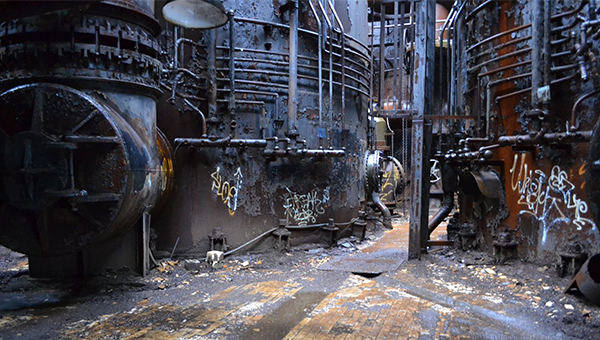 Carrie Furnace image provided by the Pittsburgh Film Office.
Carrie Furnace image provided by the Pittsburgh Film Office.
Plans to redevelop the Carrie Furnace site in the area of Rankin, Swissvale, and Braddock have been batted around for decades. With the October 2022 groundbreaking, funding in hand to complete the first two buildings by the end of 2023, and infrastructure work already underway, community leaders who have long worked and hoped for transformation are finally seeing progress.
The project, intended to breathe new life into this neglected space, is a joint venture involving the Pittsburgh Film Office (PFO) and the Regional Industrial Development Corporation (RIDC), first conceived in 2013. The vision ultimately includes mixed development, with sound stages, office space, hotels, and retail outlets. The plan will increase studio space available in the region to host companies who want to film in and around Pittsburgh.
 Architectural rendering provided by RIDC.
Architectural rendering provided by RIDC.
The student team from CMU entered the scene in 2019 when they were asked to complete a feasibility study on the project’s potential for success.
“The biggest impact was giving data points that could be assembled and shared with policy and decision makers,” explained Tim White, RIDC’s senior vice president for business development and strategy. “They did a lot of economic analysis on the various markets and really helped refine and define some of the decisions we’re making.” The data provided by the student team helped the PFO better lobby for changes and resources to support the project’s implementation.
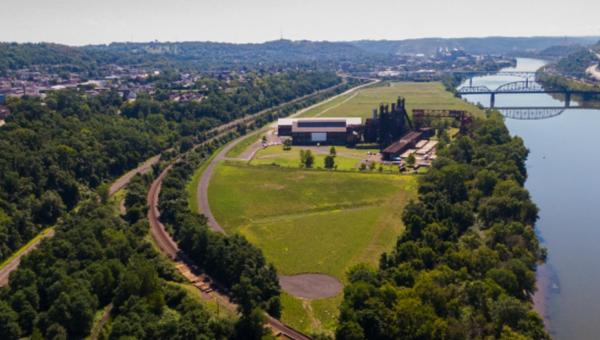
Aerial image of Carrie Furnace site provided by RIDC.
Project manager Haley Nordeen (MAM ’20) said that one of the most important contributions her team made was to compile and analyze large quantities of data from years of tax forms and tax credit submissions. The grunt work provided students with the insight to offer a key recommendation: the project would only be successful in luring more work from the film and television industry if Pennsylvania legislators would first increase the state cap on tax credits and then guarantee a multi-year commitment for those credits.
A second key component of the report was the team’s recommendation to develop workforce pipelines. Community transformation had to be about more than real estate – to be successful, the project also had to include viable jobs for people in local neighborhoods.
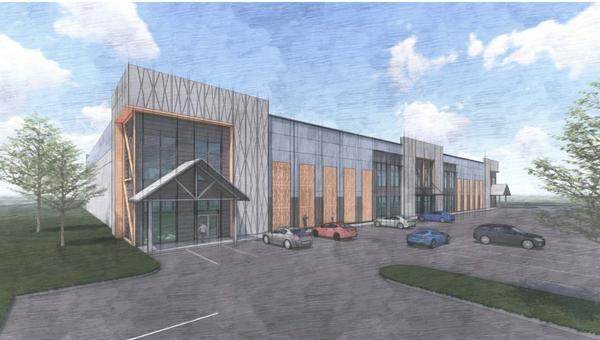
Architectural rendering of new tech-flex space provided by RIDC.
Phase one of the project involves the construction of two large buildings on the Carrie Furnace site in Rankin. The first will be a tech-flex space that could have tech uses, office spaces, and also offer supporting spaces for film industry needs. The second building will house two purpose-built sound stages, which the PFO’s director, Dawn Keezer, believes will be instrumental in attracting entertainment industry projects to the area.
The impact is going to be more money spent in the region’s economy. The impact is going to be more jobs for local residents.Dawn Keezer, Director of the Pittsburgh Film Office
“The impact is going to be more money spent in the region’s economy,” Keezer said. “The impact is going to be more jobs for local residents.”
Keezer wants to ensure that skilled workers are ready to fill those jobs. The PFO recently implemented a workforce training program. The first two cohorts, trained in grip (technicians who set up and operate the rigging for a camera) and electric work, respectively, have graduated. A third class for film hairstylists just commenced.
“The focus is on diversifying the industry from behind the camera, in partnership with the union,” Keezer explained. “It’s a direct pathway to union membership, to the jobs that will be happening at the Film Furnace in Rankin. These are family-sustaining jobs that include full benefits.”
The transformation of a community from feeling neglected and forgotten to having hope, vision, and a sense of place is no small undertaking.
Rankin Council President William “Lucky” Price and Councilman Bill Pfoff are cautiously optimistic. Both have been involved for decades in efforts to revitalize the Carrie Furnace property. Both have heard lots of talk without seeing any change.
Pfoff explained that the borough of Rankin will not see any revenue until the tech flex building is complete and has secured tenants. That said, Price hopes that Rankin residents will benefit from new jobs in the tech and film industry as the borough benefits from an increased tax base.
“The site will have a breadth of job opportunities, from GED to PhD,” White said. “Attracting investment into the community creates taxable properties that create money for the school district and for the municipality – which funds their critical services.”
The film industry has a broad array of job skillsets. “Plugging those job opportunities into the community will give willing folks an opportunity to create a career,” White said. “It might be a career that starts at that site or in that industry, but it would be a career that you could work in across the world.”
The Mulberry Project
The historic Mulberry Second Presbyterian Church in Wilkinsburg, Pennsylvania, is another of the projects currently moving forward. When completed, the main sanctuary – one of four performance spaces in the 55,000 square-foot landmark civic center – will be used as a mid-sized performance venue. The space is expected to attract local musicians, which in turn will draw audiences into the business district who can avail themselves of Wilkinsburg’s dining and shopping spots.
The facility also includes a 24-classroom education wing to be occupied by three women-led nonprofits, one offering a Spanish immersion school, another providing a wraparound program for single mothers, and the Center for Civic Arts (CfCA).
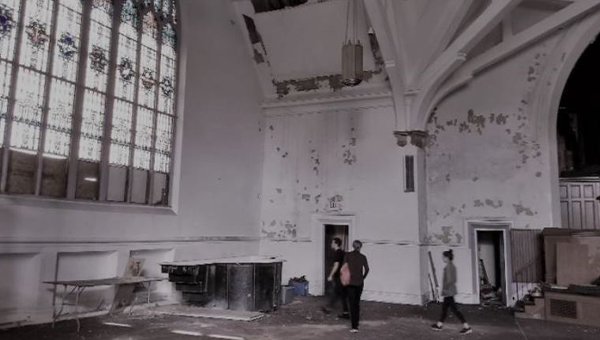
Photo of the interior of the renovation inside Second Presbyterian Church provided by Heinz student systems synthesis project team.
The CfCA – whose mission is to transform neglected cultural assets that drive grassroots community development – is the conservator of the landmark building. CfCA’s founder and director, Jody Guy, approached Heinz College for help back in 2018. Her inquiry led her to Professor Brett Ashley Crawford, faculty chair of the Master of Arts and Entertainment Management programs at CMU, to partner on a systems synthesis (a kind of capstone experience for graduate students) project. The student team was charged with creating a sustainable business plan for the church renovation – one that would incorporate the Wilkinsburg community’s desire to use the building as a performing arts space.
The team’s research was extensive, and included consultation with community members and borough leaders, as well as delving into demographic, health, and economic data for the area. The students discovered that it is quite common to use former churches as performing arts spaces.
“Whether in D.C., Maryland, or California, these organizations serve artists and the community in unique ways,” Crawford explained. “For Wilkinsburg, the goal was to create a space where the local artists would have a place to perform for community members. A place for the community to connect while drawing in people new to the neighborhood, as music and art are public goods.”
Wilkinsburg has a relatively high number of women-led families, Guy said. She hopes the CfCA will be able to add before- and after-school educational programming as well as job training programs for parents. The plan is to involve members of the local community in the civic center’s governance structure and board of directors, to avoid gentrification.
Their report was packed with so much research, including community interviews and quantitative data. I still refer back to it now when I’m writing grant proposals or we are doing strategic planning.Jody Guy, Founder and Director, Center for Civic Arts
“Their report was packed with so much research, including community interviews and quantitative data,” Guy explained. “I still refer back to it now when I’m writing grant proposals or we are doing strategic planning.”
Progress on the Mulberry Project is slower than Guy would like, but continues to move forward. She is optimistic about the potential for transformation in Wilkinsburg. Renovating and repurposing the block-long facility would not only impact local property values, but also entice new investors and residents to the area. Guy said the neighborhood’s use of the facility itself will infuse new life into the community.
Artist Residency at Saints Peter and Paul Church
The renovation project at Saints Peter and Paul Church – locally known as “the Dogma Church” for its use as a backdrop in the 1999 Kevin Smith film “Dogma” – in East Liberty, Pennsylvania, already had a business plan in place when Skip Schwab of the non-profit East Liberty Development, Inc. (ELDI) connected with Heinz students to partner on a systems synthesis project in Fall 2022.ELDI had completed a planning process with East Liberty community members that included East Liberty residents, local preservationists concerned with protecting the historic church, and local arts organizations.
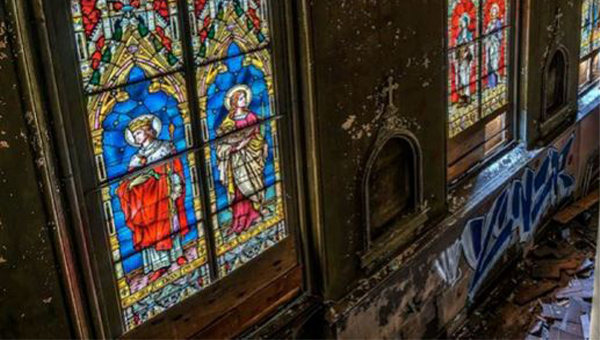
Image of disrepair inside Saints Peter and Paul Church provided by Heinz student systems synthesis project team.
“They were pretty clear that we wanted this to be a multi-use space for events, large concerts, and small arts groups, so that became the concept. The problem was figuring out the economics,” explained Schwab.
Local arts groups expressed a need for rehearsal space and a black box theater (simple, flexible performance space). ELDI worked with the Rooney Sports & Entertainment Group to develop a plan that would answer to these diverse needs and also be financially viable. Schwab reached out to Crawford to help ELDI get a better understanding of the economic landscape related to arts organizations.
“It started to come together, this idea that you could have flexible-use space in the church, and that ultimately led to the idea of an artist-in-residence program.”
The student team was charged with creating an artist residency program structure that supports diversity, equity, accessibility, and inclusion. Their final report laid out a comprehensive framework for how to support artists in residence, the make-up of selection committees, the application process, budget considerations, staffing, and physical space needs.
“It was phenomenal,” Schwab said. The depth of experience and strength of analysis the students brought to the project surprised him, and he said the quality of their work has helped to validate the project.
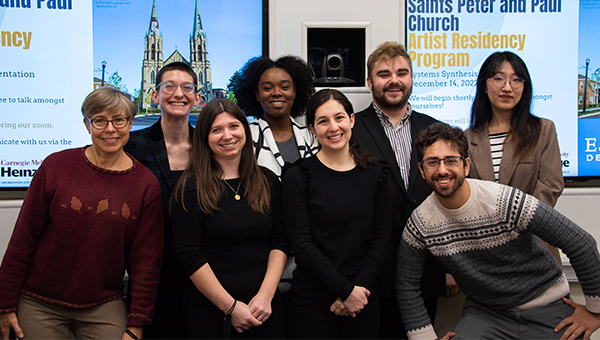
Dr. Brett Ashley Crawford and the team of graduate students who tackled this project.
ELDI has received two grants totaling $2.5 million from Pennsylvania’s Redevelopment Assistance Capital Program (RACP) to fund the church’s renovation and repurposing. The fundraising will still be significant, but Schwab said the students’ report helps to illustrate to potential partners that the redevelopment of this abandoned church into a vibrant community asset is a true need, and something the arts community is asking for.
So, no magic wand. Real transformation happens incrementally, over time, and with careful intention so that community members are included in the process and experience the benefits. The “magic” comes not from potions and spells, but from CMU’s collaboration with community stakeholders and from hours of research and analysis. With those stipulations in place, however, the arts have the potential to bring new hope, new life, new abundance – and yes, a little magic – for communities that have been struggling.